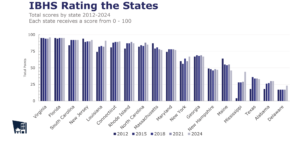When you read about another new carrier carving out market share, how do they do it?
Executive Summary
Carriers recognize that using data analytics will provide the underwriting edge they need to compete in the future, but what’s stopping existing carriers embracing data analytics? As startups move swiftly towards this goal, what barriers are holding carriers back, and what is the best approach when navigating powerful new solutions. RMS VP Farhana Alarakhiya provides some answers.Although they may not be established or a “big name,” they harness technology and use data effectively from initial prospect contact through to marketing, sales and even claims. For these businesses, data analytics now drives everything. Business decisions based on intuition, experience and relationships are losing their appeal.
PwC’s 20th Annual Global CEO survey showed 86 percent of insurance CEOs believe technology will completely reshape competition or significantly impact the industry over the next five years. And data is where the business future lies. The battle now is to outperform the competition through the utilization of data analytics and technology.
Carriers are not short of data. In fact, these new entrants would love to access the sheer volumes of data that established carriers have. It is all about how the data is analyzed and used. But for businesses where technology and processes evolved sporadically, it is easy to get boxed in by practical constraints restricting ability to change, such as:
- Fragile ecosystems. For many carriers, the “system” gets in the way of everyday business. If they had to design their systems and processes again, the designs would look nothing like what they have in place today—aging central systems, lots of bolt-on “point” solutions, workarounds, and confusion.
- Processing time robs analysis time. Can underwriters get the analysis they need? Analysts are tied with data entry, preparation, file management activities eating up most of their time. Systems designed for their roles could restore this precious analyst resource and expertise.
- Data sources stuck in silos. Combining data sources, the “2+2 = 5” value concept, drives much of the value from data. Achieving a linear chain through exposure, premium and payouts—combining modeling, exposure, contracts and claims—has obvious advantages. But with incompatible data sets, the sheer processing power required makes this physically hard to achieve on-premise.
- Latency of underwriting insights. With underwriting decisions needing to be almost instantaneous, risk analysis systems struggle. Only policies prejudged as worthy based on value, geography or risk type are modeled. But every underwriting decision, whether it’s being made on a “cookie-cutter” residential risk or on multifaceted networks of risks may benefit from comprehensive assessment to avoid underestimating potential losses that can be driven from granular or very localized characteristics.
Look to the Clouds
 For many, harnessing the cloud with scalable storage and computing power offers a remedy to overcome some of these constraints. It may save costs but constraints will still exist, and cloud storage simply moves them off premises. Those who have been tempted by this approach in the past will attest to the following issues:
For many, harnessing the cloud with scalable storage and computing power offers a remedy to overcome some of these constraints. It may save costs but constraints will still exist, and cloud storage simply moves them off premises. Those who have been tempted by this approach in the past will attest to the following issues:
Unfit technologies: Underwriting solutions originally built for on-premise use were designed to work with local networks and in-house servers. “Cloud-first” solutions can orchestrate the compute and storage power that the cloud offers rather than being retrofitted or reconfigured to do this. This eliminates adaption costs and ensures full compatibility with the cloud.
Do-it-yourself: Carriers seeking to retain experience on site to update their technology may find that all their in-house bespoke solutions and ongoing investments distract from broader business objectives. They need tailor-made systems that can orchestrate data, systems, and processes together—but with a focus on business benefit rather than system maintenance.
So, at this point it is worth thinking like a new entrant to the market. What would make the business really sing? What are the benefits of supporting your underwriting intelligence with an analytic-driven approach?
Speed is a prerequisite. The faster your analytics, the faster you can make effective underwriting decisions. Cloud-first systems that can access and assess data quickly allow you to write more quality business.
Visualizing your portfolio. Seeing risk, exposure, claims history, all together on one platform will allow your business to make strategic decisions on where to take your portfolio. The loss history is unique to your business, and provides a personalized view of the risk landscape that can be used for your competitive advantage.
Getting to real-time portfolio metrics. Driven by your strategic objectives, this must be the goal of any progressive, advanced carrier. Giving your underwriters the ability to see the real-time marginal impact of their underwriting decisions helps to fulfill those objectives one deal at a time, helping your underwriters to be more selective and proactive in their decision-making.
More informed underwriting and management decisions. This allows better price adequacy assessment and more real-time understanding of portfolio threats. With the data to effectively assess new markets, products, and regions, responsiveness to accessing the right opportunities increases.
Getting serious about data means embracing new technology and new techniques, and pressures are mounting. The ones who will survive and thrive will see opportunities presented by innovation in technology and data analytics, and identify the right partners and solutions for their own objectives.
As all new entrants understand — technological transformation in the industry is rapidly shifting from “why and when?” to “now and how?”





















 Study: Average Cyber Breach Insurance Coverage Gap is 350%
Study: Average Cyber Breach Insurance Coverage Gap is 350%  Former MLB Player Charged With Insurance Fraud in Florida
Former MLB Player Charged With Insurance Fraud in Florida  What Industry Executives Are Saying About Loss Reserves, Social Inflation
What Industry Executives Are Saying About Loss Reserves, Social Inflation  The Insurance Data Paradox: Structure Creates Flexibility
The Insurance Data Paradox: Structure Creates Flexibility 



